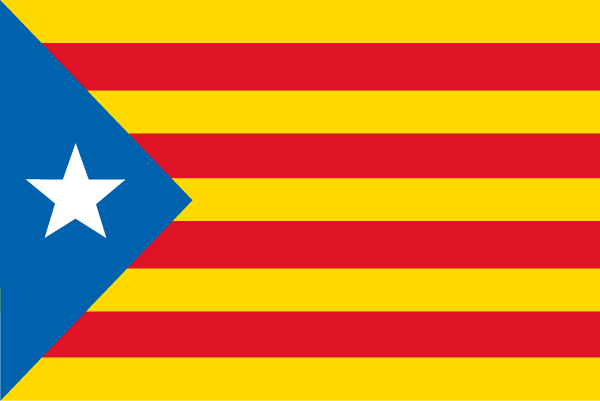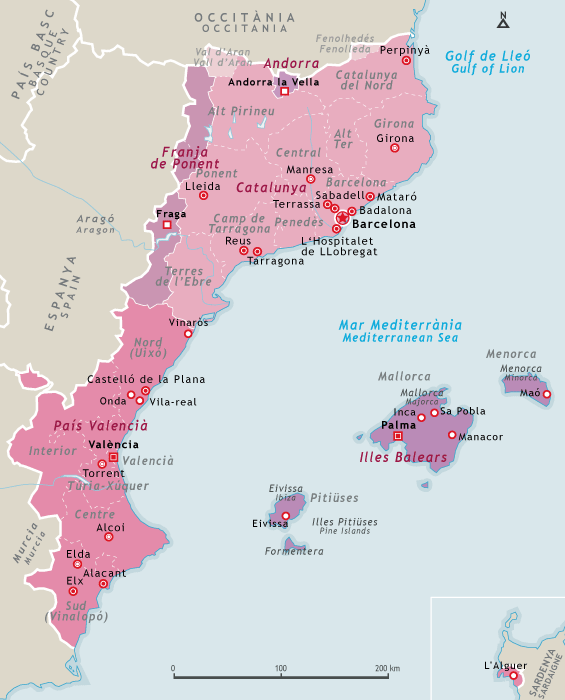Catalan countries (Catalonia), “We are a nation”

Catalonia, commonly called the Catalan countries, is a Romance nation stretching over 800 km. Lying at the extreme north-west of the Mediterranean Sea, it runs along the easternmost strip of the Iberian Peninsula, including the Balearic Islands. Apart from the principality of Andorra, the rest of the territory belongs to Spain and France.

The history of Catalonia is strongly related to Carolingian conquests (8th–9th centuries), which led to the formation of several counties, which then became a hereditary unit. Barcelona quickly became the cultural centre and its rulers were implicitly princes of Catalonia. After the union with Aragon (1137), the country stretched towards the south:
Tortosa (1109), Lleida (1139), Mallorca (1229), Valencia (1232–44), Alicante (1296) and Minorca (1302). The Catalan crown was linked to the Habsburg dynasty, but after a period of splendour from the 14th and 15th centuries, trouble arose. After the War of Succession (1697–1715), northern Catalonia came under French rule (1659), which saw the loss of Aragon. From this period on, Spanish power would periodically deny Catalan identity.
It was not until the 19th century that the revival of nationalism was widely promoted by the industrial bourgeoisie, centred in Barcelona. Catalan politics was added to the literary rebirth, the highpoint of which was undoubtedly the experiences of the Association (1910–26) and the Generalitat of Catalonia (1931–39). In the 1960s a movement appeared in favour of uniting Catalan territories under the term “Catalan countries”, inspiring the contemporary ideal of Catalan independence. In spite of these strong claims, the dominant trend has been a form of status quo limited to the defence of the strong regional claims supported by Catalonia’s powerful political parties. This has not prevented 74% of Catalonians from voting yes in a referendum on the new status of autonomy in 2006.

Identity card

| Name | Països Catalans | Catalan (Catalan Countries) Catalunya | Catalan Cataluña | Castilian (Catalonia) |
| Population | 13,712,983 inhab. (2006) |
| Area | 70,520 km² |
| Languages | Català | Catalan Castellano | Castilian Occitan | Occitan (official) Français | French |
| Number of native speakers | 10,050,000 | Catalan (2017) |
| State of guardianship | Spain, France, Italy |
| Official status | Independent state (Andorra), autonomous communities in Spain, department in France, a commune in Italy |
| Capital | Barcelona | Catalan |
| Historic religion | Roman Catholic |
| Flag | La Senyera | Catalan (The Signal) |
| Anthem | Els Segadors | Catalan (The Reapers) |
| Motto | Som i serem | Catalan (We are and we will be) |

Timeline

- 870 • Union of Catalan territories under Guifré de Rià, foreshadowing the future Catalonia.
- 1304 • Incorporation of the region of Alicante and end of southern expansion.
- 1410 • Death of Martí I and end of the Catalan dynasty, replaced by a Castilian lineage.
- 1701-15 • Bourbon victory in the War of Succession essentially leading to the incorporation of the political unification of the crown of Aragon into the kingdom of Spain.
- 1833 • The poem ‘Ode to the Motherland’ by Bonaventura Carles Aribau foreshadows the literary renaissance.
- 1910 • Creation of the commonwealth of Catalonia, first experience of an autonomous government in 200 years.
- 1931–39 • Proclamation of the Catalan Republic by Macià, leading to the creation of the Generalitat (government), which was abolished under the Franco regime.
- 1977–81 • Creation of the autonomous communities of Catalonia, the Baleric Islands and Valencia.

Brief history

The Catalonian Renaixença (renaissance) of the second half of the 19th century is considered a phenomenon halfway between the Provençal Felibrige (primarily a literary movement) and the Italian Risorgimento (clearly political). Thus, in spite of the efforts to normalise the Catalan language and culture, the general trend of Catalanism leans towards formation of a multinational Spanish state in a federal form. At the end of a period of decline (in the 18th century), called Decadència, this movement built on the recovery of Catalan as a language, not only by the promotion of diverse forms of art, theatre and literature, but also by reforming its orthography. The Renaixença stretched throughout the whole of the Catalan territory.

Geography

Covering an area of almost 70,000 km², the Catalan Country stretches for 800 km from north to south. Essentially a Mediterranean climate is found there, and there are high mountains like that of the great Cordilleras. To the north, the Pyrenees (Aneto, 3,404 m) dominate. This chain of mountains stretches more than 1,000 m to the south and along the Mediterranean. The Ebro constitutes the most important Catalan river. A great number of tributaries and smaller rivers form the drainage system of Catalonia. The urban mesh consists of large metropolises, whose two urban centres are Barcelona to the north and Valencia to the south. These two towns form larger groups, similar to metropolises, on account of their proximity to other cities. Alicante is the largest town in the south while in the north it is Perpignan. There are five major groups: Catalonia (which includes the former principality of Catalonia and northern Catalonia), the Franja de Ponent, the Valencian region, the Baleric Islands, Andorra and Alghero (Catalan town in Sardinia). The term Països Catalans (Catalan countries) describes this group. The map shows the territorial divisions into “vegueries” for the Generalitat of Catalonia (which are under development) and regions for the Valencian Community.



Language

Català
Catalan is certainly the most spoken minority language in Europe. There are more native speakers of Catalan than there are native speakers of Danish, Slovenian or Estonian, which are national languages. Ten million people speak it. Thus, the term minority seems inappropriate in this case. Catalan is a Romance language closely related to Occitan, but has certain grammatical differences. It also shares common character traits with Ibero-Romance languages, like Castilian and Portuguese. The language is divided into two groups where intercomprehension is possible: western Catalan (following a regular line from north to south, from the Pyrenees to the Valencian region) and eastern Catalan (from the Roussillon to Tarragona and including the Balearic Islands and the town of Alghero in Sardinia). Although the knowledge of Catalan by newly arrived immigrants is important, its social use is decreasing in favour of the adoption of Castilian as an intercommunitary language, especially in the large agglomerations like Barcelona or Valencia. In the autonomous community of Catalonia, more than 5.7 million people speak it. A specific language of Catalonia, according to the Statute of Autonomy in 1979, Catalan is protected by a range of laws including the 2003 Linguistic Normalisation Law establishing Catalan in all acts of civil life, in addition to Castilian. It is this that has saved Catalan. Radio and television (TV3 and Canal 33) play their role as a vehicle for the language. In the Valencian community, thanks to the Statute of Autonomy of 1982, the authorities defend bilingualism even if in a more timid manner than in the Catalonian Generalitat: many Castilian speakers are hostile to the Catalan language. In northern Catalonia, the contempt of the French authorities regarding regional languages doesn’t allow for much progress as in the south. Only a little more than 10,000 students learn it.

Politics now

Due to the division of Catalonia between several administrative divisions, the political life is different from one region to the other. For example, Andorra is a sovereign state; the north has a general council without real powers. Despite the existence of statutes of autonomy in the principality of Catalonia, Valencia and the Balearic Islands, power is controlled by the Spanish government. According to polls, 20% of Catalonians would support independence (more than 35% in the Generalitat of Catalonia), but in these past years two battles have dominated the Catalan political scene. The Catalans have wished to be recognised as a “nation” like the Scottish, and they also fight for the Catalan language to be recognised at European level, a minority language more widely spoken than some official languages. In July 2010, after experiencing tensions with the central government regarding the Statute of Autonomy, 1.5 million Catalans protested in Barcelona to remind them that they had adopted autonomy four years earlier by referendum.
The most representative nationalist parties in Catalonia
- Partit Demòcrata Europeu Català (PDeCAT) / Catalan European Democratic Party (Separatist liberal and Social Democrat coalition)
- Esquerra Republicana de Catalunya (ERC) / Republican Left of Catalonia (Separatist progressive)
- Candidatura d’Unitat Popular (CUP) / Popular Unity Candidacy (Socialism)

